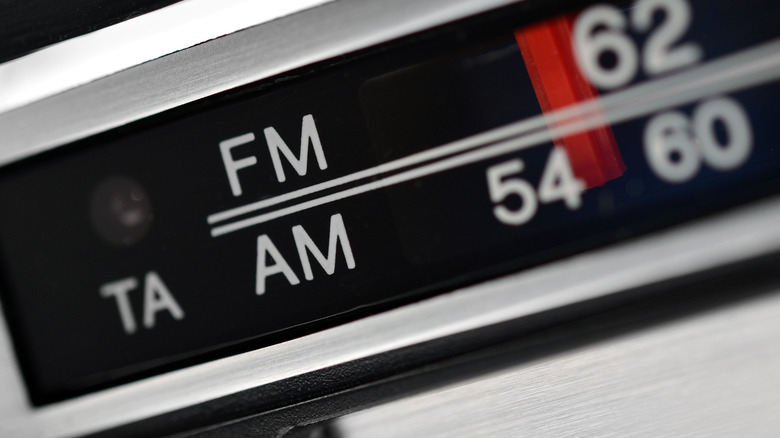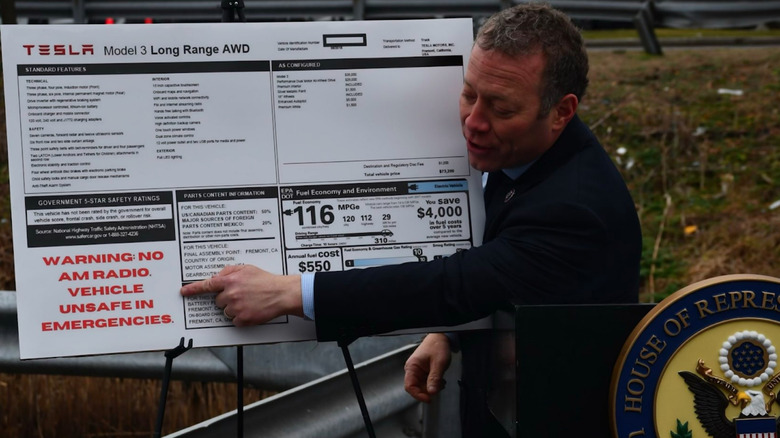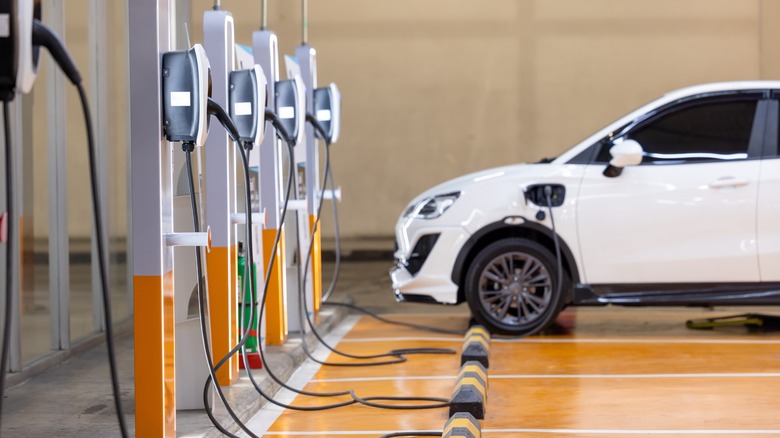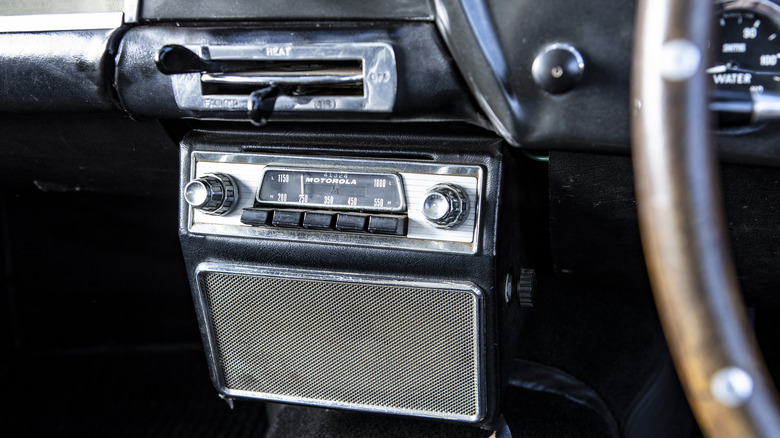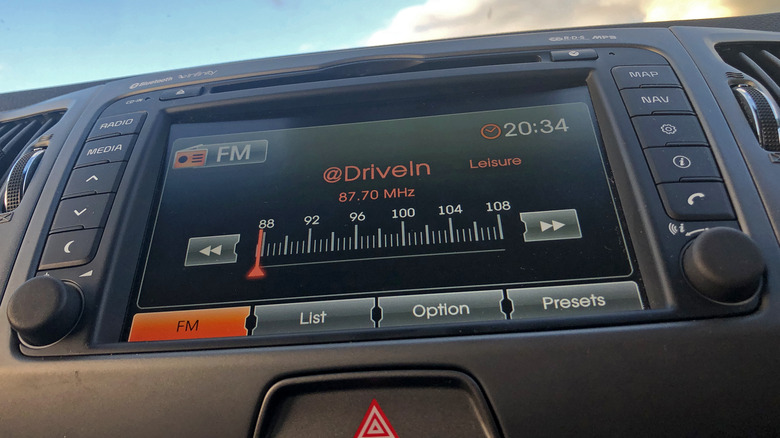Why The U.S. Government Is Fighting To Keep The AM Radio In Your Car
Over the past couple of years, some of the biggest automobile brands, including BMW, Tesla, Volkswagen, Porsche, and Audi, have dropped AM radio from their cars. The trend is particularly visible in electric cars, which are on the rise owing to a mix of lowered costs, improved charging infrastructure, greater availability, and government benefits. However, the shift hasn't been well-received by stakeholders in the broadcasting industry, agri-trade associations, members in the top policy-making halls, and of course, the folks who are reliant on the radio broadcasts for getting critical information.
"I would think that if Elon Musk has enough money to buy Twitter and send rockets to space, he can afford to include AM radio in his Tesla," Congressman Josh Gottheimer said in his campaign to preserve AM radio systems in cars, deeming them a vital system for relaying life-saving information. The biggest argument is that AM radio has proved to be a critical element in the U.S. emergency response system, having proved its merit during disasters such as "Superstorm Sandy, hurricanes in Louisiana, wildfires in California," notes the Congressman.
The pressure from broadcasting associations and the top echelons of policymaking hasn't gone unnoticed. Ford, for example, reversed course in May 2023 and announced that its new cars across all segments will be able to tune into AM radio moving forward. Some carmakers, on the other hand, point their fingers at the waning public reliance on AM radio waves for information and the technical challenges posed by radio kits, which could end up increasing the cost of electric cars and potentially affect their performance, as well. The lack of robust research into the conundrum further complicates the matter.
The challenges
In July 2023, FCC chairwoman Jessica Rosenworcel endorsed the Every Vehicle Act bill, which passed the Committee with support from Republican as well as Democrat members. In January 2024, U.S. Congressman Josh Gottheimer proposed that cars lacking AM radio will have a dedicated sticker that says "Warning: No AM Radio. Vehicle Unsafe in Certain Emergencies." AM radio has 10s of millions of weekly listeners, including agricultural communities relying on AM stations for getting weather reports critical to their business. However, it's public safety that has taken precedence when it comes to vouching for AM radio in cars.
In a sternly written letter to automakers, Senator Ed Markey claimed that "broadcast AM radio is irreplaceable," while lambasting these brands for not giving the importance of AM radio kits in cars more attention. Over half a dozen former FEMA administrators also wrote to the U.S. Department of Transportation, arguing that if carmakers continue with their offloading, the "vital public safety system" that is AM radio will cease to work as intended.
Lawmakers, on the other hand, are not inclined to let it happen. Secretary Buttegeig, a strong proponent of the AM For Every Vehicle Act, hopes that the rule, if passed, would make it mandatory for all vehicles sold on U.S. soil to offer AM radio functionality. The bill is yet to get official approval in the Senate, but it boasts strong bipartisan support. As of February 2024, it has been sponsored by 206 Congress members, with nearly equivalent strong showing from both Republicans and Democrats in the bill's favor.
Why are electric cars in the crosshairs?
Electric vehicles (EVs), in contrast to ICE-powered cars, operate using a rechargeable battery, electric motor(s), and a frequency converter. The frequency converter modulates the power output of the vehicle's electric motors by rapidly switching the voltage on and off many times per second, effectively slicing the energy into smaller portions. This action generates electromagnetic interference, which can be detected as noise by the car's radio.
It's not just about the inherent electrical motor system that can spell trouble for AM signal modules – things like power windows in a non-EV could also potentially cause interference. However, shielding an electric car inside-out from electromagnetic interference is an expensive endeavor, and at a time when even the biggest players like Tesla are eyeing $25,000 electric cars, most EV makers are inclined to remove the AM modules instead of accommodating it.
Volkswagen argues that the added weight of electromagnetic shielding hardware will bring down the electric car's range. Automakers also argue that since customers are now shifting to other internet-driven sources for information such as streaming services and internet browsing systems baked into their car infotainment systems, AM radio is no longer useful.
A volley of challenging claims
Not everyone is convinced about the perceived drawbacks of retaining AM radio systems. The National Association of Broadcasters questioned the veracity of a report claiming that automakers will have to absorb $3.8 billion in mitigation costs for fitting AM radio gear, including non-interference tech, in cars. It claims the Alliance for Automotive Innovation (AAI) study wrongly attributes the pricey interference-canceling measures to AM radio.
Moreover, the tentative government budget offered to carmakers can easily cover the mitigation costs highlighted in the AAI study, which was funded by the Center for Automotive Research (CAR). Addressing concerns that mitigation hardware would reduce the range of electric cars, the NAB claims that the interference-reducing ferrite core filter used in a Tesla Model Y is only 0.06% of the car's weight, downplaying its effect on the net range. Tom King, an expert on radio transmission tech, told Radio World that a diversity receiver can be used to cancel interference. "The application of diversity receivers in electric vehicles could be used to eliminate RF noise interference to AM reception when shielding and filtering is not sufficient," he was quoted as saying.
In the same report, Saul Levine, an industry veteran and president of a broadcasting body, also blames scientific laggardness. He pointed out how in Europe, the approach to automotive radio includes alternatives such as shortwaves that are not available in the United States. Willingness is also being seen as a hurdle. For example, Tesla cars used to offer AM radio, but the company is no longer a fan of the facility. The likes of Toyota also have no qualms about shipping AM kit in its hybrid rides, suggesting that it's not a problem, at all.
What the lawmakers and policy makers want
Late in 2022, Senator Markey sent letters to 20 automakers including Ford, GM, BMW, Honda, Tesla, and Volkswagen Group, asking them about the status of AM radio kits in their vehicles and for explanations about why they've decided not to include AM radio in applicable models, among other things. More importantly, the senator asked whether brands ditching AM radio are fitting their cars with free digital broadcast radio systems.
Congressman Josh Gottheimer also sent a letter asking all automakers to reconsider their decision to ditch AM radio in their cars and to treat it as a stock feature for the sake of public safety. The Republican voice also asked the National Highway Traffic Safety Administration (NHTSA) to fold AM radio into its Federal Motor Vehicle Safety Standards, thereby ensuring that all carmakers are required to include AM radio in their vehicles, electric or otherwise.
"As adoption of electric vehicles increases, we must not leave behind those in rural areas who depend upon radio for their news and alerts," says FCC Commissioner Nathan Simington. Citing data provided by the National Association of Farm Broadcasters, the FCC commissioner added that a majority of agricultural radio listeners — who are predominantly farmers — prefer the AM band for tuning in, spending an average of more than an hour listening each day.
